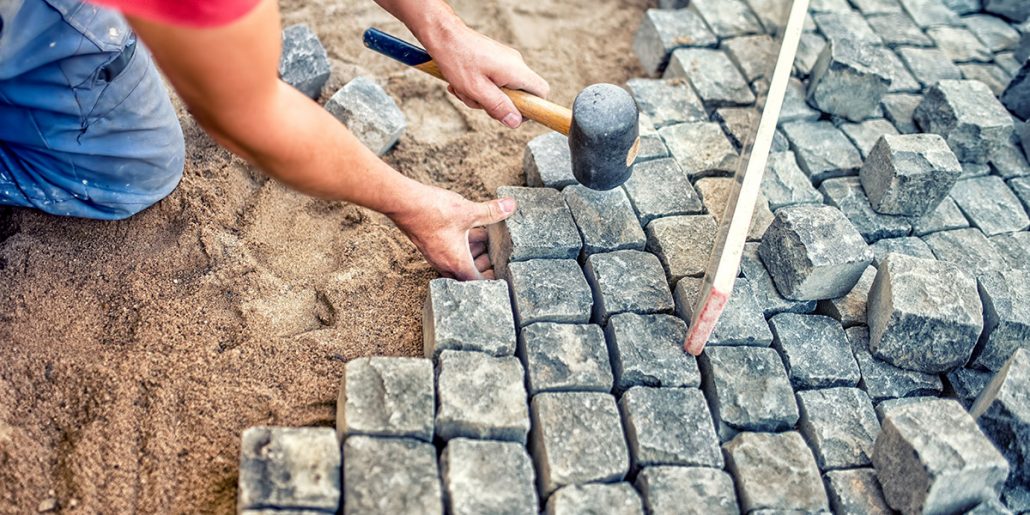Top Quality Paver Installation Services to Change Your Outdoor Area
Top Quality Paver Installation Services to Change Your Outdoor Area
Blog Article
Opening the Secrets of Lasting Stonework Building And Construction Practices for Eco-Friendly Structures
Amongst the myriad methods to environmentally friendly structure, sustainable stonework building stands out as a tried and true and resilient method that holds a riches of untapped possibility. From the option of products to cutting-edge construction methods, the secrets to accomplishing sustainability within masonry building are multifaceted and intriguing.
Benefits of Lasting Masonry Construction
Embracing lasting masonry building and construction practices not just minimizes environmental influence however likewise offers long-term economic advantages to home builders and communities. By utilizing products like recycled bricks, obstructs, and stones, home builders can dramatically decrease the carbon footprint of their projects while promoting resource effectiveness. Furthermore, sustainable stonework building and construction strategies, such as appropriate insulation and thermal mass homes, can improve power effectiveness within buildings, leading to minimized operational costs over time.
In addition, the toughness and durability of masonry structures add to long-lasting economic benefits. Buildings constructed making use of sustainable stonework practices typically call for less repair and maintenance, equating to set you back savings for home builders and homeowner. The longevity of stonework products additionally guarantees that structures remain stable and safe, lowering the requirement for frequent improvements or replacements.
Eco-Friendly Stonework Products
Using environmentally friendly masonry products is a critical action in the direction of enhancing the sustainability of building practices and minimizing ecological influence while optimizing long-term financial advantages. Sustainable stonework materials are sourced, created, and used in a manner that reduces overall ecological influence. Products such as recycled bricks, reclaimed stone, and sustainable concrete blocks are ending up being increasingly preferred options for eco-conscious contractors. Recycled blocks, for instance, not only divert waste from land fills however likewise call for less power to produce compared to brand-new bricks. Recovered rock offers a special visual allure while reducing the demand for new quarrying. Sustainable concrete blocks include recycled aggregates and might feature enhanced insulation properties, contributing to power effectiveness in buildings.
Furthermore, all-natural materials like adobe, rammed earth, and straw bundles supply excellent thermal mass properties, minimizing the requirement for heating and cooling down power. These products are typically in your area offered, advertising local economies and minimizing transportation-related carbon discharges. By selecting environment-friendly stonework materials, building and construction projects can dramatically decrease their ecological impact and add to the development of much healthier, more sustainable developed environments.
Energy-Efficient Stonework Techniques
Energy performance plays an important role in this link boosting the sustainability of masonry construction practices. One key energy-efficient masonry technique is the usage of thermal mass, which entails incorporating thick materials like concrete or brick right into the building's structure to absorb and save warm.

Innovations in Sustainable Masonry
Current developments in sustainable masonry techniques have actually caused innovative methods that are reshaping the building and construction industry. One such innovation is the advancement of self-healing concrete, which uses microorganisms embedded within the concrete to recover splits autonomously. This innovation not only decreases upkeep costs but additionally boosts the resilience of stonework frameworks, adding to their sustainability.
Another read what he said notable development is using recycled aggregates in stonework construction - masonry contractor. By including materials such as crushed ceramic waste or recycled glass into concrete blends, builders can lower the environmental influence of construction projects while preserving architectural stability. This practice not just diverts waste from land fills however likewise preserves natural deposits, making it a key innovation in lasting stonework building
Moreover, the combination of electronic layout devices, such as Structure Information Modeling (BIM), is changing the means stonework frameworks are prepared and built. BIM enables more accurate calculations, lowered product waste, and enhanced power effectiveness, inevitably resulting in even more sustainable building techniques. These technologies jointly symbolize an encouraging future for sustainable stonework construction in the age of green buildings.
Future Trends in Stonework Sustainability
With the ingenious strides made in sustainable stonework practices, the future patterns in masonry sustainability are poised to additional revolutionize the construction industry. Among the crucial fads shaping the future of masonry sustainability is the enhanced combination of technology. Developments such as Structure Information Modeling (BIM) and online fact simulations are being made use of to maximize masonry building processes, leading to decreased material waste and boosted energy efficiency in structures.
Moreover, the growth of unique sustainable products is readied to play a significant role in boosting the eco-friendliness of masonry building Your Domain Name and construction. masonry contractor. Innovations like self-healing concrete, recycled accumulations, and bio-based binders are obtaining grip for their capacity to lessen ecological influence while maintaining architectural integrity

Verdict
In verdict, lasting stonework building and construction practices offer numerous advantages for eco-friendly structures. masonry contractor. Developments in lasting stonework are continually being created to even more boost the ecological performance of structures.
Report this page